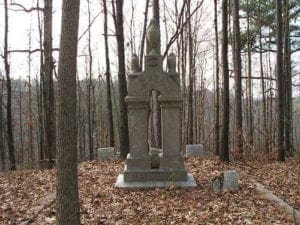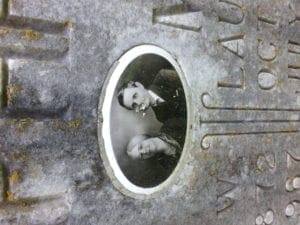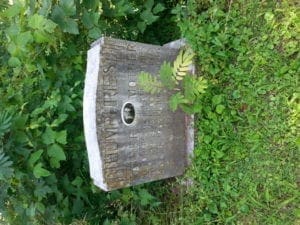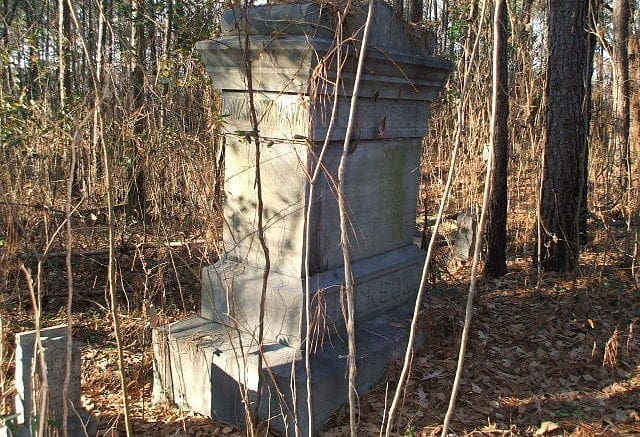This is a revised and expanded version of a story originally published in the Courier in May 2016. At that time, the Cobb County Courier was called River Edges and covered both sides of the river. With the Chattahoochee RiverLands project now in full swing, we intend to cover both sides of the river again. Hollywood Cemetery has Proctor Creek, a focus of Chattahoochee RiverLands.
This is the first in a series of articles tracing the history of Atlanta’s Hollywood Cemetery.
I’ve been fascinated with Hollywood Cemetery for about 20 years. It’s a large cemetery on the far west side of the City of Atlanta, where Proctor Creek intersects with Hollywood Road.
It has been neglected for a very long time, but if restored, it could be one of the most beautiful cemeteries in metro Atlanta.
The terrain is gorgeous. Proctor Creek runs through part of the cemetery, and much of the cemetery is terraced into hills. Although some of the masonry is damaged, there is fantastic amount of elaborate granite and marble hardscaping that is still intact, some of it, ironically, protected by the overgrowth.

The cemetery was organized in 1890. On November 8 of that year the Atlanta Constitution announced,
“Hollywood
“A New Cemetery.
“Its officers are: President, Thomas Moore; treasurer, C.J. Simmons; secretary, W. Asbury Baker; directors, John W. Nelms, John Colvin, R.S. Wynn, H.D. Smith and J.T. Greene. Messrs. Moore, Simmons, and Baker are the proprietors of the enterprise, and these three gentlemen are arranging to build a railroad from Atlanta to the cemetery, and from there to the Chattahoochee River, and back to Atlanta.
“The company is surveying and plotting burial lots, and ‘The Hollywood’ will be ready to receive internments by December 1st next.
“It is useless to refer to the business qualifications of Messrs. Moore, Baker, and Simmons, as they are known to be successful financiers. Dr. Baker is comparative stranger in Atlanta. He came from Charleston, South Carolina, and is the son-in-law of ex-Governor A.G. McGrath, and a gentleman of brains and splendid business qualifications. We bespeak success for the enterprise. Their office is 7 ½ N. Broad Street.”

The presence of C. Jerome Simmons in the list of officers had special importance due to the business strategy of the cemetery. Cornelius Jerome Simmons was a prominent lawyer and entrepreneur. His grandfather, Thomas Simmons, was a pioneer settler of the Atlanta area, who set up a saw and grist mill on Sugar Creek in the 1820s. That mill figured prominently in the history of East Atlanta under the name Terry’s Mill (Thomas Terry was the stepson of Thomas Simmons, who managed the mill after the older Simmons died). Most significantly, C.J. Simmons was president of one of Atlanta’s growing number of electric streetcar companies.
Hollywood Cemetery originated as a streetcar cemetery. Before the cemetery corporation was formed, Simmons already had plans to build a rail line from Atlanta to the cemetery, from there to the Chattahoochee River, and then back to Atlanta. The rail line would include a funeral car to transport coffins and mourners. When the line was completed, it ran from Luckie Street in downtown Atlanta, along Bankhead Highway (now Hollowell Parkway), up Hollywood Road with a stop at the cemetery, and continued to the river. Its terminal point was northeast of Paul Avenue and due north of Bolton Road, near present-day Marietta Boulevard.
The steady growth of Atlanta’s population in the late 19th century created fierce competition among street car companies that catered to the rapidly growing population. Companies often create their own markets by organizing related businesses. The most common practice of this type was the development of subdivisions. Inman Park, East Atlanta, and Ormewood Park were streetcar suburbs where the housing was developed in tandem with the extension of rail lines. In the case of Hollywood Cemetery, the street car and the cemetery complemented each other. The rail line could supplement routine travel between Atlanta and the towns along the Chattahoochee with its funeral and burial business.
An 1893 Atlanta Constitution article gushed with purple prose over the cemetery in a feature entitled “Pretty Hollywood — A Cemetery That Is an Honor to Atlanta.”
“It is one of the most lovely landscapes in Georgia, with handsome drives, ornamental shrubbery, winding walks, and all the elements to characterize it as an ideal and imposing City of the Dead. It is of easy access from Atlanta, being on the new electric car line to the Chattahoochee River, over which a car passes in each directions every thirty minutes.”
They weren’t exaggerating the beauty of the terrain. Even today, in its neglected state, the hills, stream, and trees are impressive.
The article went on to assure readers that the cost of transportation and burial at the cemetery would remain affordable. Transporting a coffin and mourners was guaranteed to remain at $15 round trip, and the plots were $12.50-$25, with finance terms of $1.5o down payment, and $1 per month.


The article emphasized the local standing of the cemetery’s owner, and once again highlighted the cemetery’s affiliation with the streetcar system.
“Hollywood, although controlled by what is known as the Hollywood Cemetery Company, is not owned by capitalists as other cemeteries are, but is the property of W.A. Baker exclusively. This gentleman is prominently known as one of the constructors of the Chattahoochee Electric Railroad, and he is a gentleman who stands high in the confidence and regard of the public at large.”
Despite the rosy predictions by the newspaper, Hollywood Cemetery had a rocky start in its first decades of operation. The next article in this series will examine the legal disputes and controversies that accompanied the cemetery’s early days.

